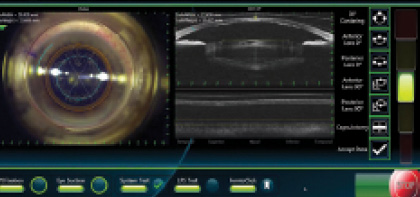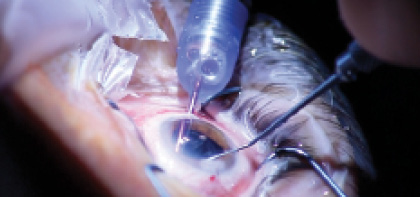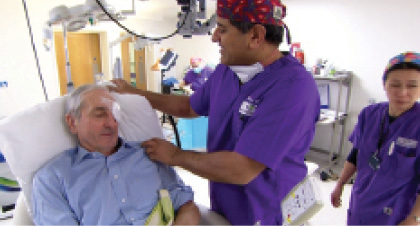As a consultant ophthalmologist, I had my suspicions around 5 or 6 years ago that I had the beginning stages of cataracts. I went to see my friend, the well-known ophthalmologist and Chief Medical Editor of CRST Europe, Sheraz M. Daya, MD, FACP, FACS, FRCS(Ed), FRCOphth, for an official diagnosis.
My eyesight had started to fail me gradually, and I had become increasingly dependent on glasses, which I found to be a nuisance. My vision problems left me struggling to use the computer, a tool that is imperative for my work. Even a round of golf with friends was proving embarrassing, as everyone had to point out the location of the golf ball for me. The turning point was when I felt that driving on the motorway at night and in bad weather was becoming increasingly tricky and dangerous. It was then that I decided to finally have something done about it.
WATCH IT NOW

Figure 1. Victus treatment screen: Capsulotomy has been completed.

Figure 2. Dr. Daya performs phacoemulsification on Dr. Condon's eye.

Figure 3. Drs. Condon (left) and Daya (right), after surgery.
The decision to opt for laser-assisted cataract surgery (LACS) was not a light one, but, having myself performed standard phacoemulsification techniques many times, I was fully aware of the risks and knew the advantages of LACS over manual surgery. Because I have known Sheraz for a number of years and have always been impressed with his work, there was no question in my mind about allowing him to perform LACS on my eyes. The Centre for Sight was the obvious choice of clinic, as I knew that the staff and facilities were of the highest standard.
The initial surgery on my first eye took place at the end of February 2014 (Figures 1 through 3; eyetube.net/?v=odofo), and I underwent surgery on my second eye about 4 weeks later. Having been an ophthalmologist for many years, I was impressed at how techniques for surgery have vastly improved over the years, not only in terms of safety but also in patient well-being and comfort. For example, anesthesia for the eye was administered using drops rather than injection.
As a patient, I was naturally concerned and felt tense. However, the staff at Centre for Sight proved to be superb, putting me immediately at ease with their relaxed and thorough manner. Watching carefully to ensure that everything was done by the book, I observed the staff's professionalism to be excellent.
After surgery, I was delighted by the results, noticing the clarity and sharpness of vision to be fantastic. I no longer needed glasses except for very close work. Being mostly free from glasses was a gratifying feeling. It was also interesting to finally understand exactly how so many of my own patients feel after their surgeries.
Before surgery, I felt that I, like many other people experiencing age-related vision problems, had adapted to losing my sight, and afterward it was a truly wonderful feeling to get it back. n
Patrick I. Condon, MCh, FRCS, FRCOphth
- Medical Director, Waterford Eye Specialists, Waterford, Ireland
- pcondon251@eircom.net
- Financial disclosure: None

